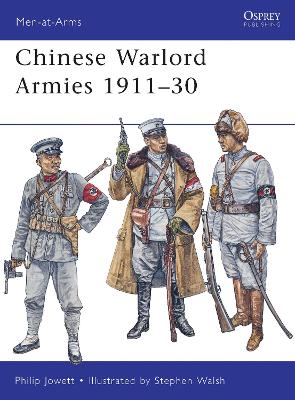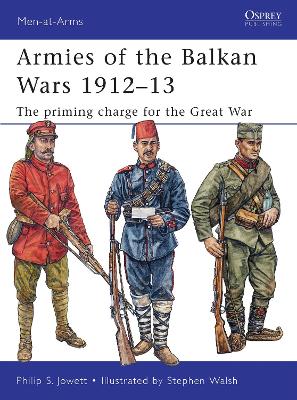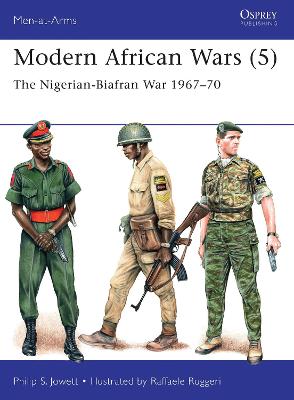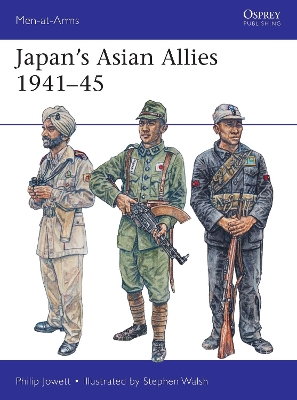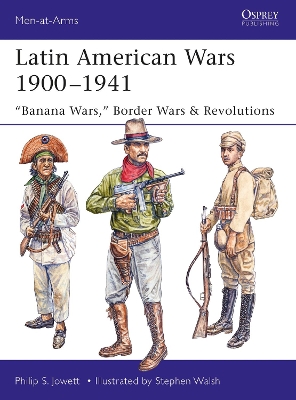Men-at-Arms
3 primary works • 6 total works
Book 463
Defeated in the Sino-Japanese War 1894-95 and the Boxer Rebellion of 1900, Imperial China collapsed into revolution and a republic was proclaimed in 1912. From the death of the first president in 1916 to the rise of the Nationalist Kuomintang government in 1926, the differing regions of this vast country were ruled by endlessly forming, breaking and re-forming alliances of regional generals who ruled as 'warlords'. These warlords acted essentially as local kings and much like Sengoku-period Japan, fewer, larger power-blocks emerged, fielding armies hundreds of thousands strong. In the mid- to late 1920s some of these regional warlords. This book will reveal each great warlord as well as the organization of their forces which acquired much and very varied weaponry from the west including the latest French air force bombers. They were also joined by Japanese, White Russian and some Western soldiers of fortune which adds even more colour to a fascinating and oft-forgotten period.
Book 466
In 1912, the Balkan states formed an alliance in an effort to break free from the crumbling Ottoman Empire. Forming an army of some 645,000 troops from Greece, Bulgaria, Serbia and Montenego, they took on a force of 400,000 Turkish soldiers. Both sides were equipped with the latest weapons technology. This book looks at the diverse and sometimes colourful uniforms worn by both sides, paying special attention to insignia, weapons and equipment. It also gives an overview of the campaigns that became a 'priming pan' of World War I.
Book 501
This is a comprehensive guide to the armies that fought a devastating and decisive conflict in the Eastern Mediterranean between the two World Wars of the 20th century. From the initial Greek invasion, designed to "liberate" the 100,000 ethnic Greeks that lived in Western Turkey and had done for centuries, to Mustafa Kemal Ataturk's incredibly efficient formation of a national government and a regular army, this was a war that shaped the geopolitical landscape of the Mediterranean to this day. It gave birth to the modern Turkish state, displacing millions and creating bitter memories of atrocities committed by both sides. Augmented with very rare photographs and beautiful illustrations, this ground-breaking title explores the history, organization, and appearance of the armies, both guerilla and conventional, that fought in this bloody war.
With decades of research to draw from Philip Jowett explores this extraordinary David-and-Goliath conflict, where the rag-tag Igbo tribal army of secessionist Biafra faced off against the Nigerian Federal forces. It was an African war that captured the attention of the western media, with individual commanders such as Biafran leader Colonel Ojukwu and Federal Colonel Adekunle becoming familiar figures across the globe. The Nigerian forces easily outnumbered their opponents and benefitted from British and Soviet equipment, yet against all the odds the Biafrans held out for two and a half years, inflicting many setbacks on the Federal forces before their eventual surrender in 1970.
Specially commissioned artwork and historical photos, including some from respected Italian war photographer Romano Ganoni, reflect the diverse array of uniforms and equipment on both sides, with images ranging from Sandhurst-educated officers in immaculate uniform to ragged militiamen armed with World War II kit.
Specially commissioned artwork and historical photos, including some from respected Italian war photographer Romano Ganoni, reflect the diverse array of uniforms and equipment on both sides, with images ranging from Sandhurst-educated officers in immaculate uniform to ragged militiamen armed with World War II kit.
During the Japanese occupation of large parts of Asia and the Pacific in 1941-45, Japan raised significant numbers of troops to fight alongside them, as well as militias to guard their conquests. The total number of these soldiers is estimated at no fewer than 600,000 men. These ranged from the regular troops of Manchukuo (200,000 men), Nanking China (250,000), Thailand, and recruits from the 'puppet' Burmese Independence Army (30,000) and Indian National Army (40,000), to constabularies and spear-wielding militias in the Philippines (15,000), Borneo, Indonesia and New Guinea.
Many of the recruits from former European colonies hoped for independence as part of the 'Greater East-Asian Co-Prosperity Sphere' proclaimed by Japanese propaganda, but Japan's intentions were entirely cynical. They formed alliances to deny the Allied powers access to territory that they could not actually occupy, and raised these large numbers of auxiliary troops to relieve the manpower burden of occupation, or simply as 'cannon-fodder'.
This extensively researched study examines each of these armies and militias in detail, exploring their history and deployment during World War II, and revealing the intricacies of their arms and equipment with stunning full-colour artwork and previously unpublished contemporary photographs.
Many of the recruits from former European colonies hoped for independence as part of the 'Greater East-Asian Co-Prosperity Sphere' proclaimed by Japanese propaganda, but Japan's intentions were entirely cynical. They formed alliances to deny the Allied powers access to territory that they could not actually occupy, and raised these large numbers of auxiliary troops to relieve the manpower burden of occupation, or simply as 'cannon-fodder'.
This extensively researched study examines each of these armies and militias in detail, exploring their history and deployment during World War II, and revealing the intricacies of their arms and equipment with stunning full-colour artwork and previously unpublished contemporary photographs.
From the Mexican Revolution to the Zarumilla War, in the first 40 years of the 20th century the nations of Central and South America were frequently disturbed by border clashes, civil wars and revolution. Many of these conflicts became known as 'Banana Wars'. Some involved only lightly armed guerrillas, but others saw armies operating artillery and armoured vehicles, supported by aircraft and river navies. The conflicts in Honduras and Nicaragua saw the intervention of US Marines, and later wars involved armour and aircraft from the militaries of Europe.
Using detailed colour plates and a wealth of contemporary photographs, this book shows the uniforms, equipment and strategies of the armies involved in these conflicts little known in the West. Covering wars crossing the length and breadth of the continent, this is the fascinating account of the wars that helped shape modern Latin America.
Using detailed colour plates and a wealth of contemporary photographs, this book shows the uniforms, equipment and strategies of the armies involved in these conflicts little known in the West. Covering wars crossing the length and breadth of the continent, this is the fascinating account of the wars that helped shape modern Latin America.
